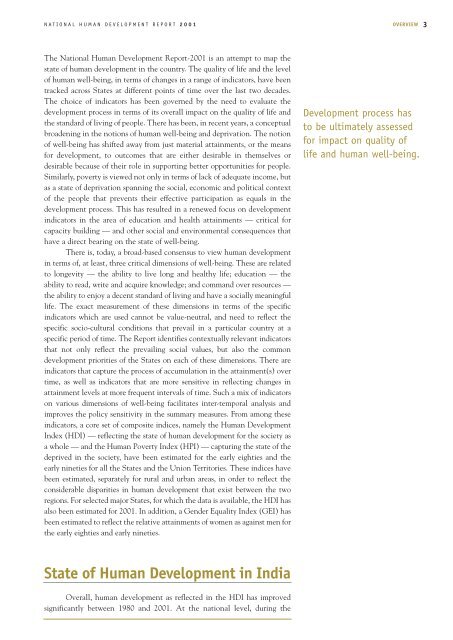National Human Development Report: 2001 - Indira Gandhi Institute ...
National Human Development Report: 2001 - Indira Gandhi Institute ...
National Human Development Report: 2001 - Indira Gandhi Institute ...
- No tags were found...
You also want an ePaper? Increase the reach of your titles
YUMPU automatically turns print PDFs into web optimized ePapers that Google loves.
NATIONAL HUMAN DEVELOPMENT REPORT <strong>2001</strong> OVERVIEW 3The <strong>National</strong> <strong>Human</strong> <strong>Development</strong> <strong>Report</strong>-<strong>2001</strong> is an attempt to map thestate of human development in the country. The quality of life and the levelof human well-being, in terms of changes in a range of indicators, have beentracked across States at different points of time over the last two decades.The choice of indicators has been governed by the need to evaluate thedevelopment process in terms of its overall impact on the quality of life andthe standard of living of people. There has been, in recent years, a conceptualbroadening in the notions of human well-being and deprivation. The notionof well-being has shifted away from just material attainments, or the meansfor development, to outcomes that are either desirable in themselves ordesirable because of their role in supporting better opportunities for people.Similarly, poverty is viewed not only in terms of lack of adequate income, butas a state of deprivation spanning the social, economic and political contextof the people that prevents their effective participation as equals in thedevelopment process. This has resulted in a renewed focus on developmentindicators in the area of education and health attainments — critical forcapacity building — and other social and environmental consequences thathave a direct bearing on the state of well-being.There is, today, a broad-based consensus to view human developmentin terms of, at least, three critical dimensions of well-being. These are relatedto longevity — the ability to live long and healthy life; education — theability to read, write and acquire knowledge; and command over resources —the ability to enjoy a decent standard of living and have a socially meaningfullife. The exact measurement of these dimensions in terms of the specificindicators which are used cannot be value-neutral, and need to reflect thespecific socio-cultural conditions that prevail in a particular country at aspecific period of time. The <strong>Report</strong> identifies contextually relevant indicatorsthat not only reflect the prevailing social values, but also the commondevelopment priorities of the States on each of these dimensions. There areindicators that capture the process of accumulation in the attainment(s) overtime, as well as indicators that are more sensitive in reflecting changes inattainment levels at more frequent intervals of time. Such a mix of indicatorson various dimensions of well-being facilitates inter-temporal analysis andimproves the policy sensitivity in the summary measures. From among theseindicators, a core set of composite indices, namely the <strong>Human</strong> <strong>Development</strong>Index (HDI) — reflecting the state of human development for the society asa whole — and the <strong>Human</strong> Poverty Index (HPI) — capturing the state of thedeprived in the society, have been estimated for the early eighties and theearly nineties for all the States and the Union Territories. These indices havebeen estimated, separately for rural and urban areas, in order to reflect theconsiderable disparities in human development that exist between the tworegions. For selected major States, for which the data is available, the HDI hasalso been estimated for <strong>2001</strong>. In addition, a Gender Equality Index (GEI) hasbeen estimated to reflect the relative attainments of women as against men forthe early eighties and early nineties.<strong>Development</strong> process hasto be ultimately assessedfor impact on quality oflife and human well-being.State of <strong>Human</strong> <strong>Development</strong> in IndiaOverall, human development as reflected in the HDI has improvedsignificantly between 1980 and <strong>2001</strong>. At the national level, during the

















